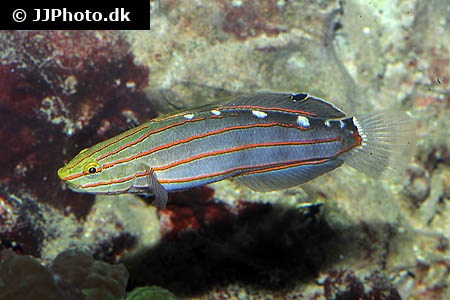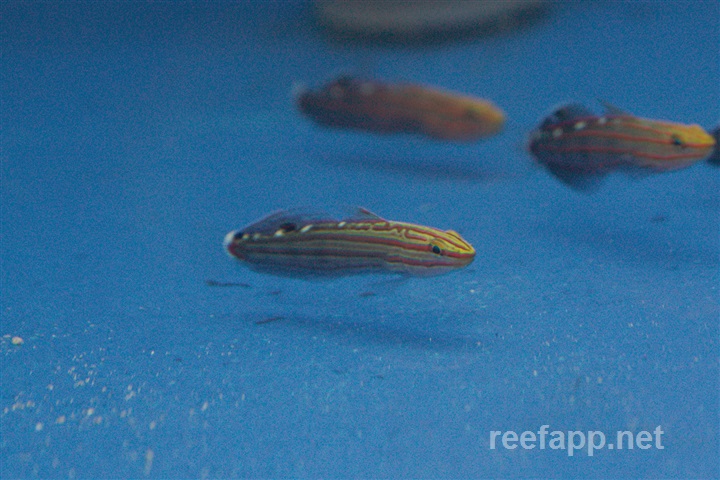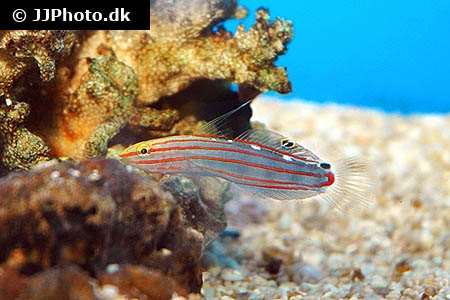Koumansetta rainfordi
| Latin name | Koumansetta rainfordi - Whitley, 1940 |
|---|---|
| Local name | Court Jester Goby |
| Family | Gobiidae - Koumansetta |
| Origin | Australia, Indonesia, East Pacific, Central/West Pacific |
| Max length | 8 cm (3.1") |
| Minimum volume |
150 l (40 gal) |
|---|---|
| Hardiness |
Average |
| Suitable for aquarium |
Experience, preparation and extra care required |
| Reef safe |
Always reef safe |
| Aggressiveness | Mostly peaceful but might be aggressive towards similar species |
| Recommended |
Microalgea (Eg. spirulina) Small crustaceans (Krill, mysis, artemia...) Zooplankton (Cyclops, pods...) |
|---|
This species is known to jump out of open aquaria.
Hard to give this species the correct nutrition and is therefore hard to keep alive.
This species assist in keeping the sandy substrate clean by filtering sand in search for food.
Compared to other sand dwelling gobies this one is not as proficient at filtering the sand.
These fish should be kept in a well run aquarium where they can "graze" algae from rocks and stones.
If there are insufficient algae on the rocks, it is important to feed more frequently and supplement with algae rich food e.g. Spirulina.
This species can live as a pair (male and female).
This species needs good hiding places, for example, between live rocks.
This species can be bred in captivity, one can therefore consider asking your local fish store for a captive bred specimen.
Koumansetta rainfordi often starve to death as it needs filamentous algae in the tank to graze.
Synonym: Amblygobius rainfordi.
Gobies (Gobiidae) are generally small fish, which live close to the bottom. Many of the species are fairly hardy and well suited to aquaria. The behaviour of the different kinds of Gobies varies greatly and some can be very interesting.
The most common types of Gobies in aquaria are the following:
Sand eating Gobies (Amblygobius, Koumansetta and Valenciennea)
Sand eaters filter the sand through their mouths and out of their gills.
They are generally bigger than other Gobies, but they are usually peaceful, so size is not a problem.. They can however be aggressive towards their own species.
One must be aware that they can eradicate the micro life in the substrate when the tank is too small. If there is not enough live food in the sand, it can be difficult to ensure the fish stay in good condition, as they require frequent feeding.
They may spread sand across the corals when they eat.
Shrimp Gobies (Amblyeleotris, Cryptocentrus and Stonogbiops)
Shrimp Gobies have a symbiotic relationship with Pistol shrimps, but one must first find out which species can live together.
The shrimp and Goby live together in a small hole in the sand or under a stone where the shrimp maintains the hole, so it will not collapse over time. The Goby helps by looking out for enemies, since the shrimp does not see well in sunlight, as it will have become accustomed its vision to the darkness of the hole.
Neon Gobies (Elacatinus/Gobiosoma)
Thesef Gobies are very small and like the Cleaner Wrasse, it eats parasites off other fish.
These Gobies are easier to keep alive in the aquarium than Cleaner Wrasses, as they can eat a wide range of foods.
Clown Gobies (Gobiodon)
These fish are very small and therefore suitable for small aquariums. Clown Gobies will often hide inbetween the branches of stony corals, like Acropora for example.
They generally eat many types of food, as long as it is small enough.
| Aquarium trade | Yes |
|---|---|
| Distribution | Western Pacific: Philippines south to Rowley Shoals and the southern Great Barrier Reef and east to Fiji (Ref. 37816). Recently reported from Tonga (Ref. 53797). |
| English common names |
Old glory Red-striped goby |
Scott Michael. 2005. Aquarium Fish: Gobies of the Genus Amblygobius - Advanced Aquarist - (English)
Scott W. Michael. Reef Aquarium Fishes: 500+ Essential-to-know Species - TFH Publications / Microcosm Ltd. - (English)
James W. Fatherree. 2011. Aquarium Fish: A Look at the Gobies - Advanced Aquarist - (English)
Bob Fenner. "True" or Combtooth Gobies, the Family Gobiidae - Wet Web Media - (English)




